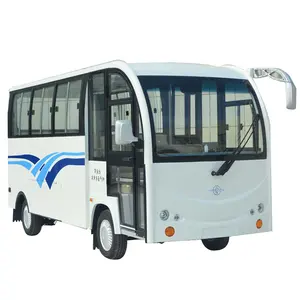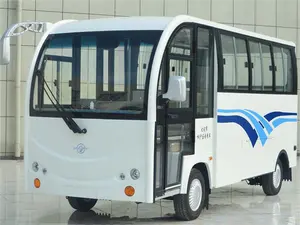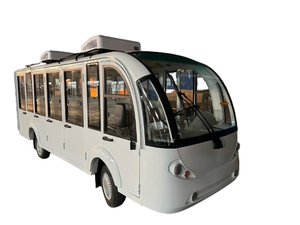(1223 products available)


































































































































































































India mini bus are also referred to as mini buses or small buses. They are a smaller version of the standard bus that is designed to carry passengers. Mini buses are used for transportation services, such as school transportation, airport shuttles, and private charters. They are also used for public transport in many cities and rural areas in India. The India mini bus offers a comfortable ride with features such as air conditioning, reclining seats, and entertainment systems.
There are different types of India mini buses, which include the following:
Conversion Mini Buses
Conversion mini buses are created by transforming passenger vans into buses. The seating capacity is increased by adding more seats and removing the van's cargo area. The enhanced seating area is designed for comfort and features amenities such as climate control and entertainment systems.
Cutaway Chassis Mini Buses
Cutaway chassis mini buses are built on a cutaway van chassis with a custom bus body installed. The cutaway chassis provides a solid foundation for the mini bus, and the bus body is constructed using lightweight materials to improve fuel efficiency. The mini bus can be configured to have different seating arrangements and installed with various amenities.
Micro Buses
Micro buses are the smallest type of mini buses. They are designed to carry up to 10 to 30 passengers. Micro buses are often used for special transportation needs, such as transporting passengers to and from school and airport shuttles. They can be configured to have different seating arrangements and are also equipped with safety features such as seat belts and airbags.
Luxury Mini Buses
Luxury mini buses are designed for luxury and comfort. They are equipped with modern amenities such as climate control, entertainment systems, and luxury seating arrangements. The buses are often used for corporate events, weddings, and other special events. The luxury mini buses are well fitted with safety features such as advanced airbag systems, ABS brakes, and other safety features.
Accessible Mini Buses
Accessible mini buses are designed to accommodate passengers with mobility challenges. They are fitted with accessibility features such as wheelchair lifts, secure wheelchair slots, and wider door openings to enhance accessibility. The accessible mini buses also have seating arrangements that can be configured to accommodate more passengers.
Engine:
The heart of any bus, including the Mini bus, is the engine. It provides the power needed to operate the bus. Mini bus engines can vary in size and type depending on the model being discussed. They may include gasoline or diesel engines with varying horsepower and torque ratings.
Transmission:
It works in tandem with the engine to transfer power to the wheels of the bus, allowing it to move. Mini buses may be equipped with automatic or manual transmissions, depending on the model and configuration.
Chassis:
This is the bus's body frame, which serves as the foundation for other components, such as the engine, transmission, and wheels. The bus chassis is designed to offer strength, durability, and stability to support the vehicle's overall structure and performance.
Seating Capacity:
The mini buses are designed to accommodate more people compared to other vehicles. The seating capacity may vary depending on the specific model of the bus. Generally, a mini bus can carry 10 to 30 passengers comfortably.
Suspension:
The suspension system of a mini bus is designed to provide comfort and stability during the ride, for both the passengers and the driver. It is made up of components such as springs, shock absorbers, and linkages that connect the bus to its wheels, controlling the bus's direction and stability.
Brakes:
Brakes are essential for every vehicle, including mini buses, as they help slow down or stop the bus when necessary. Mini buses are typically equipped with disc brakes or drum brakes on the front and rear wheels. The braking system is designed to ensure effective and reliable braking performance, even when transporting passengers or cargo.
Tires:
Mini bus tires are crucial for offering traction, stability, and safe handling on various road surfaces. The size and type of tires may vary depending on the specific model of the mini bus, as they are designed to meet the unique requirements of each vehicle.
Electrical System:
This system powers the electrical components of the mini bus, such as lights, signals, and the horn. Depending on the model, the electrical system may include batteries, alternators, and wiring harnesses to ensure reliable power supply and operation of various electrical components.
Air Conditioning and Heating:
Some mini bus models may be equipped with air conditioning and heating systems to ensure a comfortable environment for passengers and drivers, regardless of the weather conditions.
Safety Features:
Safety is a top priority in every vehicle, including mini buses. Various safety features may be available in mini buses, such as seat belts, anti-lock braking systems (ABS), electronic stability control (ESC), and a reinforced passenger compartment to provide optimal safety and protection for passengers and drivers.
To keep the India mini bus in good condition and performance, regular maintenance is essential. Here are some general guidelines for maintaining mini buses:
In addition, according to the requirements of the manufacturer or professional maintenance personnel, mini bus owners can also consider performing some more complex maintenance operations, such as engine tuning, transmission adjustment, brake system overhaul, and so on.
With several options available, choosing an appropriate mini bus for a specific need can be challenging. Here are some tips to keep in mind before purchasing or renting a mini bus:
Here is a step-by-step guide on how to DIY and replace India mini buses:
Assess the needs
Check the condition of the bus to be replaced and the requirements of the users to be served. This assessment will help determine what is to be replaced and what is to be expected from the new bus.
Budget
Prepare a budget that will cater to the replacement process. This will include the cost of purchasing the bus and any other requirements.
Source the funds
Source funds by looking for alternatives like taking loans or using available savings.
Make arrangements for the replacement
Once the budget has been prepared and funds sourced, arrangements will be made for the replacement process. This includes the time to carry out the replacement and the logistics involved.
Inform stakeholders
Users, parents, and relevant authorities will be informed about the replacement process and the arrangements made.
Transfer information and belongings
Transfer all relevant information and arrangements to the new bus. This includes safety equipment, communication devices, and emergency procedures. All personal belongings will be transferred to the new bus before the replacement.
Familiarization
Users and other stakeholders will be familiarized with the new bus and its operational procedures. This ensures a smooth transition and minimizes any disruptions.
Monitor the transition
Once the replacement is complete, the transition will be monitored to ensure everything is functioning properly. Any issues will be addressed promptly.
Q1: Do mini buses have good safety features?
A1: Safety is a big concern in the design and making of the mini bus. These vehicles are fitted with safety features like seat belts for all passengers, sturdy body structures, crumple zones, and fire extinguishers. Some also have first aid kits and emergency exit doors. The safety features make the mini bus a good choice for schools, companies, and public transport.
Q2: Is the India mini bus good for long-distance travel?
A2: The India mini bus is good for long-distance travel. The buses that are made for long-distance travel have comfortable seats that are spacious and can recline. They also have adequate legroom, air conditioning, and good ventilation. Other features that make the mini bus good for long-distance travel are entertainment systems, storage space for luggage, and accessible toilets.
Q3: Is the India mini bus good for hilly areas?
A3: The mini bus is good for hilly areas. It has a powerful engine that gives it high torque. The high torque helps with driving on steep slopes. The mini bus has a good braking system that gives it effective braking power. It also has a compact design and good handling, which makes it easy to navigate narrow roads. Its reliable suspension system gives stability and a good ride quality.